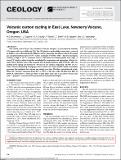Files in this item
Volcanic carbon cycling in East Lake, Newberry Volcano, Oregon, USA
Item metadata
| dc.contributor.author | Brumberg, Hilary | |
| dc.contributor.author | Capece , Lena | |
| dc.contributor.author | Cauley, Christina | |
| dc.contributor.author | Smith, Celeste | |
| dc.contributor.author | Tartell, Paula | |
| dc.contributor.author | Wagner, Molly | |
| dc.contributor.author | Varekamp , Johan | |
| dc.date.accessioned | 2022-10-03T16:30:18Z | |
| dc.date.available | 2022-10-03T16:30:18Z | |
| dc.date.issued | 2021-06-01 | |
| dc.identifier | 281507010 | |
| dc.identifier | 766a73b0-5f19-4d71-b61e-78de2dab088f | |
| dc.identifier | 85108173270 | |
| dc.identifier.citation | Brumberg , H , Capece , L , Cauley , C , Smith , C , Tartell , P , Wagner , M & Varekamp , J 2021 , ' Volcanic carbon cycling in East Lake, Newberry Volcano, Oregon, USA ' , Geology , vol. 49 , no. 6 , pp. 718-722 . https://doi.org/10.1130/G48388.1 | en |
| dc.identifier.issn | 0016-8505 | |
| dc.identifier.uri | https://hdl.handle.net/10023/26125 | |
| dc.description | Funding was provided by Wesleyan University, Connecticut (Stearns Chair Fund to Varekamp); Keck Consortium, Minnesota (2015, grant NSF-REU 1358987); Connecticut Space Grant Consortium/NASA (awards P-1268-2017 to Wagner and P-1323-2018 to Cauley); and a Mazamas (Oregon) Outdoor Education Foundation grant (2017, to Wagner). | en |
| dc.description.abstract | The carbon cycle in East Lake (Newberry Volcano, Oregon, USA) is fueled by volcanic CO2 inputs with traces of Hg and H2S. The CO2 dissolves in deep lake waters and is removed in shallow waters through largely diffusive surface degassing and photosynthesis. Escaping gas and photosynthate have low δ13C values, leading to δ13C(DIC) (DIC—dissolved inorganic carbon) as high as +5.7‰ in surface waters, well above the common global lake range. A steep δ13C depth gradient is further established by respiration and absorption of light volcanic CO2 in bottom waters. The seasonal CO2 degassing starts at >100 t CO2/day after ice melting in the spring and declines to ∼40 t/day in late summer, degassing ∼11,700 t CO2/yr. Thus, volcano monitoring through gas fluxes from crater lakes should consider lacustrine processes that modulate the volcanic gas output over time. The flux contribution of a bubbling CO2 “hotspot” increased from 20% to >90% of the lake-wide CO2 flux from 2015 to 2019 CE, followed by a “toxic gas alert” in July 2020. East Lake is an active volcanic lake with a “geogenic” ecosystem driven primarily by hydrothermal inputs. | |
| dc.format.extent | 5 | |
| dc.format.extent | 1174604 | |
| dc.language.iso | eng | |
| dc.relation.ispartof | Geology | en |
| dc.subject | QE Geology | en |
| dc.subject | DAS | en |
| dc.subject | NIS | en |
| dc.subject | MCC | en |
| dc.subject | NCAD | en |
| dc.subject.lcc | QE | en |
| dc.title | Volcanic carbon cycling in East Lake, Newberry Volcano, Oregon, USA | en |
| dc.type | Journal article | en |
| dc.contributor.institution | University of St Andrews. School of Earth & Environmental Sciences | en |
| dc.identifier.doi | 10.1130/G48388.1 | |
| dc.description.status | Peer reviewed | en |
This item appears in the following Collection(s)
Items in the St Andrews Research Repository are protected by copyright, with all rights reserved, unless otherwise indicated.

